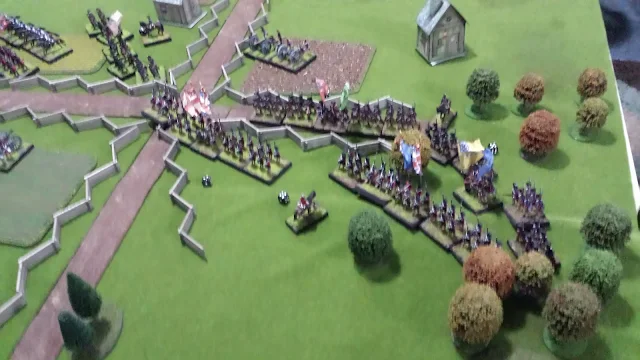On the Fire and Drum miniatures website, Jim Purky has placed his Rev War rules. There are one page, and contain all you need to play a game.
The rules are a you go, I go type. Each side rolls a dice at start of turn. High side gets to choose if they move first and fire second or move second and fire first. Firing, melee and morale are on a matrix where you cross check troop type and situation. The number shown is rolled for on a d10 looking for that number or less. Morale checks flow down a chart as you take more casualties. You roll two or more dice and have to get that number or less. Fail on one die you become shaken. Fail on two and you rout. You get additional dice for having a commander present or a terrain advantage. But how ever many dice you roll you must pass on two of them. The rules look simple enough, and people who have played them say they are fun. I like simple rules. They let you play the game and not the rules. So, I wanted to give these a try. I threw some terrain on the table, added a few regiments. The following game is not a tactical masterpiece, but a attempt to explain the rules and try them out.
The Americans have the Cross road and the British want it. The American commanders right flank had a woods and a small ridge behind it. He placed his rifle regiment in the woods with a Continental line battalion backing them up on the ridge. His center was held by two militia
battalions and two medium guns and the 3rd Light Dragoons. The left flank was covered by the 1st and 2nd Maryland regiments.
The British commanded advanced on the left flank with both battalions of the 71st Highlanders and the Loyalist lights against the rifles and militia. The 23rd, 33rd and Lights advanced against the Marylanders. Cavalry was in reserve and artillery in the center.
Turn 1. British rolled high; they moved second and fired first. Americans held fast while British advanced into rifle range. British artillery fired at long range and caused one casualty on the militia. Because they suffered casualties the militia tested
morale. They rolled two dice, plus a third dice because a commander was with them. To pass they must roll there number or less on two of three dice. They roll the number on two but not the third dice, so they pass. American rifles missed by the wayy.
Turn 2. British again rolled high, again picked move second fire first. British continues the advance. American Artillery fire and miss. Rifles fire and hit causing two casualties on Loyalists who pass
Turn 3. British move first fire second. 2/71st charges rifles, who as skirmishes can retire. But they must roll a morale check. They pass on one dice but fail on the second so are shaken. I let them retire shaken. Not sure if this is correct but that is how I played it. The Royal Artillery move into close range. Artillery can do two actions (move and unlimited or limber and move) in addition to fire. So they move, unlimber and fire. The 1/71 fires at the militia who suffer six casualties from the artillery and Highlanders. When they check morale they fail on two dice so rout! I do not let them fire during there turn instead I
move them back the routed distance. The Light Infantry fire at the 1st Maryland who pass their morale test. The 1st Maryland return fire and the Lights must test morale. They roll two dice and fail on both so they rout.
Turn 4. Americans move second fire first. Regiments on both sides charge.
The 3rd Light dragons charge the 1/71st. The 1/71st passes morale so I let them fire and they cause two hits. The Dragoons pass so they fight! Both sides roll one die per four figures. Dragons are looking for 6 or less (advantage charging infantry without secured flanks) while
Highlanders look for 5 or less. I fight two rounds of melee one after the other and at end there are six dragons casualties and four dead highlander. Dragons test morale and fail on one dice so are shaken. I have them retire. Since The dragoons retire I do not have the Highlanders check morale.
The 23rd charge the 1st Maryland. But the Marylanders were shaken by previous fire so they drop one level on the charts ( from C to D).
After two rounds of melee the Marylanders have more casualties then the 23rd so they test morale first. They fail on two dice so they rout.
At this point I called the game. Time to get to bed as I have work tomorrow! What did I learn? These are a fun set of rules. They flow quickly. There are serious advantages to who fires or moves first. If you fire first the other side has less figures to return fire (if you cause hits). Moving first you can charge and pin an opponent. Morale is interesting. You always roll two dice and have to pass on two dice. If you have a commander, or terrain advantage you add dice, but still must pass on two. I need to play a few more times but what I like about these rules are you worry about tactics and not did I forget some obscure rule. Simple rules but not so simple results.









Beautiful and bloody crossroads! Sounds like a great and intense game!
ReplyDeleteShort and informative little reply, Mark! Gives one a general feeling for the rules. Good job!
ReplyDeleteI must give them a try
ReplyDeleteI know Jim P is of the "big battalions" school of gaming, and I see that your units have a hefty figure count. Is that a coincidence or are 24-36 figures per unit part of the rules?
ReplyDelete